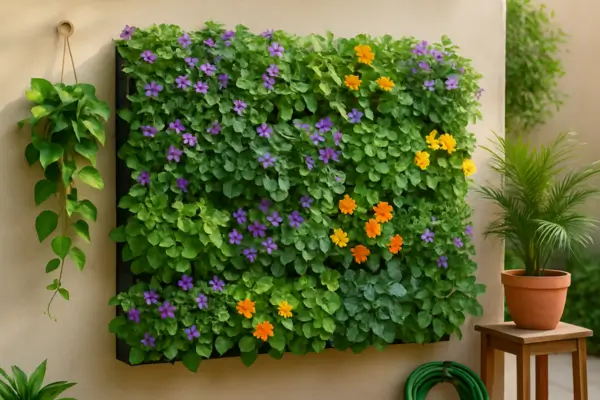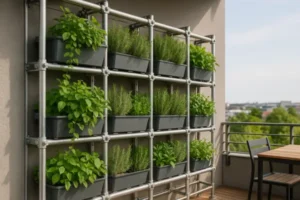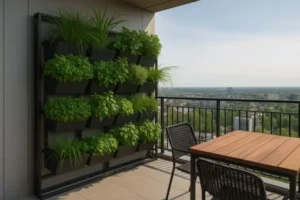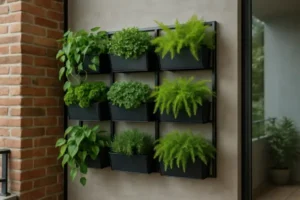Modular vertical garden maintenance is a simple part of enjoying your space. With just a few regular habits, you can keep your structure fresh, organized, and working just the way you like.
Over time, you’ll notice small changes—like a plant growing faster in one spot or a module needing a quick adjustment. These moments are easy to handle when you understand how your garden responds.
This guide brings you clear and practical tips to keep your vertical garden clean, stable, and visually balanced—all without making it feel like a task.
Modular Vertical Garden Maintenance: Checking the Structure Regularly
Taking care of modular vertical garden maintenance starts with a simple habit: checking your structure regularly. Just a quick glance helps you stay familiar with how everything is positioned and growing.
This routine makes it easier to spot natural changes—like a plant spreading out or a module shifting slightly—so you can adjust as needed and keep everything in harmony.
What Should You Be Looking For?
Your eyes and hands will tell you most of what you need to know. Just take a few minutes every week to:
- Gently shake the frame: Is it still firmly in place? A bit of movement may be normal, but anything loose needs adjusting.
- Look at the connectors or brackets: Over time, especially in areas with wind or moisture, these parts might loosen or develop rust. Tighten or replace when necessary.
- Check the wall or surface behind the garden: Sometimes, water can slowly seep into the surface behind your structure. This might lead to stains or damage over time, depending on the material of your wall.
These are small things, but when ignored, they can turn into more serious issues. Regular attention helps keep everything balanced.
How Often Should You Check It?
For most people, a quick structural check once a week is enough. If your garden is exposed to more intense conditions like wind, heat, or heavy watering, twice a week might be a better rhythm.
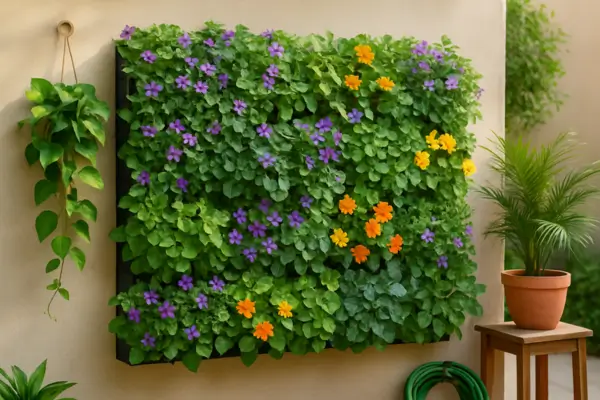
Over time, you’ll get faster and more intuitive at this. A one-minute habit today can save you hours later. Think of it as a way to protect your plants by making sure their “home” stays reliable and steady.
How to Clean the Modules Without Damaging the Setup
When it comes to modular vertical garden maintenance, cleaning the structure sounds more intimidating than it actually is. Most of the time, it’s not about scrubbing every inch—it’s about knowing what needs attention and how to handle it without messing up your setup.
Start with the Obvious: Dust, Debris, and Mineral Buildup
Whether your modules are made of plastic, metal, or composite materials, they’re constantly exposed to moisture, dirt, and falling leaves. This buildup can clog drainage holes, stain the surface, or even attract mold over time.
- Use a soft brush or dry cloth weekly to remove dust and loose debris from the surface and edges.
- For deeper buildup, a mix of warm water and mild soap usually does the trick. Avoid harsh chemicals, especially if your garden holds edible herbs or vegetables.
Take care around the roots. You don’t need to remove the plants to clean the modules—just support them gently while wiping the outer structure.
Drainage Holes Need Attention Too
One of the most overlooked parts of any vertical system is drainage. If the water doesn’t flow out easily, your plants will struggle—and so will the structure.
Here’s what you can do:
- Tilt the module slightly to see if water runs freely.
- If not, use a bamboo skewer or thin brush to clear any blockages. Do this carefully to avoid damaging plant roots.
This kind of cleaning doesn’t need to be frequent—once every two weeks is usually enough, unless you live in a dusty or humid area.
Watering in a Modular Vertical Garden: Finding the Right Rhythm
One of the most common questions in modular vertical garden maintenance is about watering: How often? How much? And how do you make sure every plant gets what it needs without overdoing it?
The truth is, vertical gardens behave differently than traditional pots or beds. Gravity plays a big role here, and water tends to drain quickly from top to bottom—sometimes too quickly.
Why One-Size-Fits-All Doesn’t Work
Each module might be holding a different type of plant, with its own preferences for moisture. Some herbs love a bit of dryness between waterings. Others, like leafy greens, prefer consistently moist soil.
So instead of sticking to a fixed schedule, try this approach:
- Check the top layer of soil with your finger every two or three days. If it feels dry about one inch deep, it’s time to water.
- Pay attention to the plants at the top of the system—they dry out faster than those below.
- Consider grouping plants by moisture needs in each column to make watering more efficient.
Tools That Help Make It Easier
If you’re looking for less guesswork and better flow, a few simple tools can make a big difference:
- Self-watering modules or inserts can reduce watering frequency.
- A drip irrigation kit with a timer offers consistent moisture and saves you time.
- Even a simple watering can with a narrow spout lets you target specific plants without flooding the whole structure.
The key is consistency, not excess. A little planning in how you water will keep your vertical garden healthy, balanced, and far less messy.
Managing Growth: When and How to Prune or Replace Plants
As part of your ongoing modular vertical garden maintenance, one task that keeps everything fresh and thriving is managing plant growth.
Over time, some plants get too big, others start fading, and a few just stop thriving in their spots. That’s normal—and it’s also your chance to make the garden even better.
Why Rotation Matters in Vertical Gardens
In a modular setup, light and water don’t always reach every module equally. Plants at the top may get more sun, while lower ones stay more humid. That means each section has its own microclimate—and not all plants will love where they’re placed forever.
Here’s what helps:
- Rotate plants every few weeks, especially if you notice uneven growth.
- If a plant is fading, try moving it to another spot before replacing it.
- Keep an eye out for root-bound plants. These tend to stop growing and may need a larger container—or a little time to recover in a different part of the garden.
Pruning Keeps It Healthy and Tidy
Trimming your plants isn’t just about looks—it helps redirect energy and keeps the structure breathable.
Try this:
- Pinch off dead or yellow leaves regularly to reduce clutter.
- For bushier growth, prune just above a node where new leaves are forming.
- Use clean scissors and avoid over-trimming in one go. It’s better to prune lightly and more often.
Not every plant is a keeper forever. And that’s okay. A modular garden is meant to evolve. Swap out what’s not working and enjoy the process—it’s part of the rhythm.
Visual Refresh: Updating the Look Without Replanting Everything
One of the most satisfying parts of modular vertical garden maintenance is knowing that you don’t need to start from scratch to make it feel new again. Sometimes, all it takes is a small visual tweak to bring fresh energy into your space.
Simple Swaps That Make a Big Difference
You can refresh the layout and look of your garden with a few easy tricks:
- Rearrange your modules or containers. Most modular systems let you move individual parts. Switching a row or rotating the layout instantly changes the composition.
- Add small design elements like colorful plant markers, natural wood trims, or neutral pebbles around the base of each plant. These subtle changes give your garden structure a clean, curated look—without replanting a thing.
- If your garden is on a balcony wall, try changing the backdrop. A piece of fabric, bamboo matting, or even a painted panel behind the structure can dramatically shift the mood of your setup.
Let the Plants Speak for the Season
You don’t need to overhaul the whole garden with every season. Instead, update just a few visual details:
- Swap in seasonal herbs or fast-growing accents, like nasturtiums or basil, to reflect the time of year.
- Move plants with bright foliage or flowers to more central positions when they’re in bloom. It draws attention naturally.
This approach keeps things feeling fresh, personal, and creative—without the stress of redoing everything. And best of all, it keeps your garden enjoyable, not overwhelming.
Make the Surrounding Space Work for You
When thinking about modular vertical garden maintenance, it helps to look beyond the structure itself. The area around your garden can play a big role in how easy it is to care for and enjoy your setup.
Keep Practical Tools Nearby
Having a few essential items close at hand saves time and makes your routine smoother:
- Add a small shelf, hook, or storage box near the garden to hold things like scissors, a watering can, or plant food.
- Keep a soft cloth or brush nearby for quick cleaning when needed.
This avoids back-and-forth and keeps everything ready to use—especially helpful if your garden is on a balcony or compact area.
Use the Space Around the Garden
Simple changes to the surrounding area can improve how your garden looks and functions:
- If your garden gets uneven sunlight, place light-colored panels or reflective surfaces nearby to brighten shaded spots.
- Add a tray or mat under the structure to catch excess water and keep the floor clean.
- If your system is movable, using wheels or sliders can help you adjust the position based on weather, light, or airflow.
These small adjustments don’t require replanting or redesigning. They simply make the space more supportive and easier to use every day.
Frequently Asked Questions About Modular Vertical Garden Maintenance
Here are some common questions that can help you get the most out of your vertical garden setup:
How often should I check my modular vertical garden?
Once a week is usually enough for a quick check. Look at the structure, feel the soil, and notice how the plants are growing. If your garden is in a hot or windy area, twice a week might be a better routine.
Do I need special tools to maintain a modular vertical garden?
No special tools are required. A soft brush, scissors, a small watering can, and a cloth for cleaning are usually enough. You can also add a drip irrigation system or self-watering inserts if you want less daily work.
What’s the best way to clean the structure?
Use a damp cloth or soft brush to remove dust and dirt from the surface. For mineral buildup, mild soap and warm water work well. Avoid using any strong cleaners, especially if you grow herbs or vegetables.
How do I avoid overwatering the plants?
Check the top layer of soil with your finger. If it feels dry about one inch down, it’s time to water. Plants at the top dry out faster than those below, so check each section before watering. Drip systems and self-watering units also help control moisture levels.
Can I move the modules around?
Yes, one of the benefits of modular systems is flexibility. You can rotate plants, switch module positions, or adjust the layout to match sunlight, airflow, or growth patterns. Just make sure everything is secure after moving.
What should I do if one plant grows faster than the others?
You can trim it lightly to keep the shape balanced or move it to a spot with less light to slow down its growth. Modular systems make it easy to swap positions without disturbing the rest of the setup.
Can I use regular potting soil in a modular vertical garden?
Yes, but choose a light, well-draining mix. You can improve it by adding perlite or coconut coir. This helps water flow properly through each module and prevents soggy roots.
Conclusion
Keeping up with modular vertical garden maintenance isn’t about perfection—it’s about creating a routine that fits your space and your lifestyle. With just a few mindful habits, your garden stays neat, balanced, and full of life.
From checking the structure to watering smarter and refreshing the layout, each step adds a layer of care that makes a real difference. And over time, it all becomes second nature—something you do almost without thinking, because the results are rewarding.
Every small action you take helps your garden work better and look the way you like. That’s what keeps it practical, simple, and truly yours.

